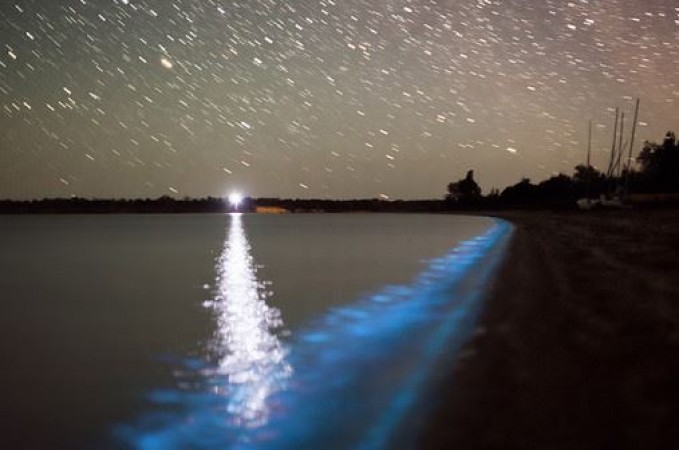
Imagine a world where organisms emit their own light, illuminating the darkness with a magical glow. Bioluminescence brings this enchanting phenomenon to life, captivating our imagination and showcasing the wonders of nature. From the depths of the ocean to the mysterious forests, bioluminescent organisms mesmerize us with their radiant displays. In this article, we will explore the captivating world of bioluminescence and discover the fascinating organisms that produce their own light.
1. Introduction
Bioluminescence refers to the ability of certain organisms to produce light through a biochemical reaction. This extraordinary phenomenon has evolved independently in various lineages across the tree of life. From the depths of the ocean to the darkest forests, bioluminescence has captured the curiosity of scientists and nature enthusiasts alike.
2. What is Bioluminescence?
Bioluminescence is the emission of light by living organisms as a result of a chemical reaction. It occurs due to the presence of luciferin, a light-emitting pigment, and an enzyme called luciferase. When luciferin reacts with oxygen in the presence of luciferase, it produces light without generating heat. This unique process allows bioluminescent organisms to create their own light source.
3. The Mechanism Behind Bioluminescence
The mechanism of bioluminescence involves a series of complex chemical reactions. First, luciferin and luciferase combine in the presence of adenosine triphosphate (ATP) and oxygen. The reaction releases energy, exciting the luciferin molecule. As the excited luciferin returns to its ground state, it emits light, resulting in the characteristic glow associated with bioluminescence.
4. Bioluminescent Deep-Sea Creatures
The depths of the ocean conceal a breathtaking array of bioluminescent organisms. Deep-sea creatures such as anglerfish, jellyfish, and certain species of squids and shrimps possess bioluminescent capabilities. These adaptations aid in communication, attracting prey, and camouflaging in their dark environment.
5. Bioluminescent Insects and Arachnids
Insects and arachnids also showcase bioluminescence in various forms. Fireflies, for example, use bioluminescence to attract mates. The synchronous flashing of fireflies in summer nights creates a magical spectacle. Other bioluminescent insects include glowworms, click beetles, and certain species of millipedes.
6. Glowing Fungi and Mushrooms
While we often associate bioluminescence with animals, some fungi and mushrooms also possess the ability to glow. These luminescent fungi, such as the famous Jack-O'-Lantern mushroom, emit an eerie greenish glow in the dark. The exact purpose of this bioluminescence in fungi is still a subject of scientific investigation.
7. Bioluminescence in Marine Organisms
Marine ecosystems harbor an abundance of bioluminescent organisms. Dinoflagellates, a type of single-celled algae, produce a sparkling bioluminescent display known as the "red tide" when disturbed. This phenomenon creates a captivating spectacle in coastal waters. Additionally, certain marine bacteria emit light, contributing to the mesmerizing glow of the ocean at night.
8. Fireflies: Nature's Own Light Show
Fireflies, also known as lightning bugs, are one of the most iconic examples of bioluminescence. These enchanting insects use their glowing abdomens to communicate with potential mates. Their rhythmic flashes create a symphony of light, transforming summer nights into a magical experience.
9. Bioluminescent Algae and Bacteria
Bioluminescent algae, such as Noctiluca scintillans and Pyrocystis fusiformis, create stunning displays of light in the ocean. These microscopic organisms emit flashes of bioluminescence when disturbed, contributing to the ethereal glow of the sea. Additionally, certain bacteria, like Vibrio fischeri, are bioluminescent and play a crucial role in various biological processes.
10. Bioluminescent Animals on Land
While bioluminescence is commonly associated with marine environments, some land-dwelling organisms possess this extraordinary ability. For instance, certain species of beetles and snails produce their own light. These terrestrial bioluminescent organisms have adapted to thrive in unique ecological niches.
11. Bioluminescence in Plants
Although rare, bioluminescence can also be found in the plant kingdom. Certain species of mushrooms, including the ghost fungus and the honey mushroom, emit a faint glow in the darkness. The purpose of this bioluminescence in plants is still not fully understood, but it adds to the enchantment of the natural world.
12. The Role of Bioluminescence in Ecosystems
Bioluminescence serves various functions within ecosystems. It aids in attracting prey, deterring predators, and facilitating communication among individuals of the same species. The mesmerizing light displays produced by bioluminescent organisms are crucial for their survival and contribute to the overall balance of the ecosystems they inhabit.
13. Medical and Technological Applications of Bioluminescence
Beyond its natural beauty, bioluminescence has practical applications in medicine and technology. Bioluminescent markers are utilized in medical research to track biological processes, study gene expression, and develop diagnostic tools. Furthermore, scientists are exploring the potential of bioluminescence in lighting technologies, creating sustainable and energy-efficient solutions.
14. The Future of Bioluminescent Research
As our understanding of bioluminescence expands, so do the possibilities for future research. Scientists are delving deeper into the genetic and biochemical mechanisms behind bioluminescence, uncovering new insights into this captivating phenomenon. With advancements in technology, we can expect groundbreaking discoveries that further unravel the mysteries of bioluminescence.
15. Conclusion
Bioluminescence invites us into a world filled with enchantment and awe. From the depths of the ocean to the forest floor, organisms that produce their own light captivate us with their radiant displays. As we continue to explore and understand bioluminescence, we gain a deeper appreciation for the remarkable wonders of nature.
Rupee Charges Ahead: Indian Currency Surges 6 Ps USDollar, Reflecting Investor Confidence
23 Airports Set for Major Upgrades to Boost Traffic and Elevate Travel Experience
Sensex and Nifty Soar to All-Time Highs, Fueling Investor Confidence in India's Economic Recovery